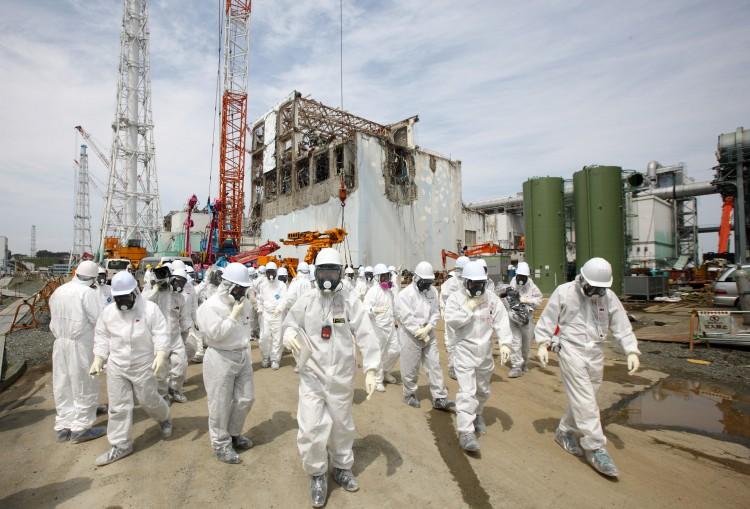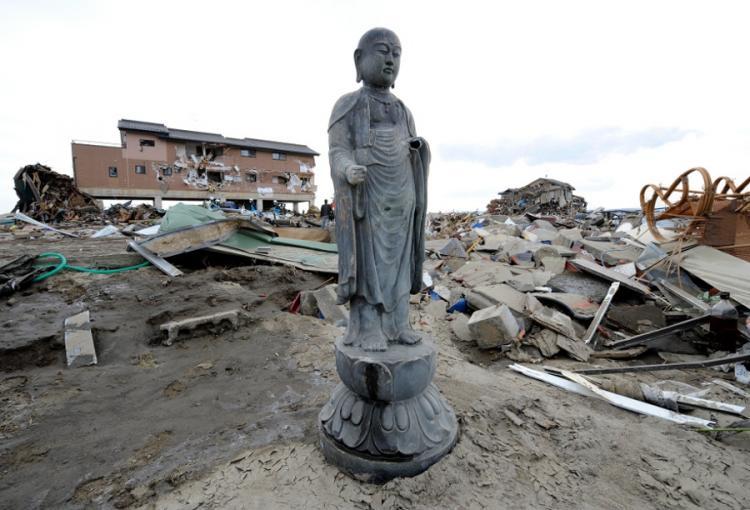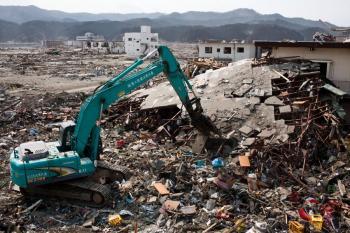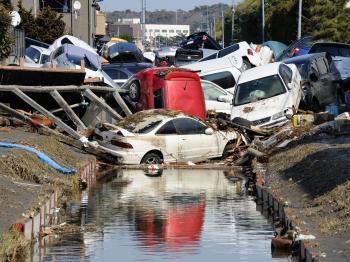Focus
tsunamis
Major Earthquake Preparedness: Response Strategies for Different Scenarios
Comprehensive expert-backed strategies for surviving earthquakes in Japan, from home to outdoors.
|
Hawaii Downgrades Tsunami Warning After Quake
A magnitude-7.7 earthquake that hit western Canada over the weekend prompted Hawaii to issue a tsunami warning before it downgraded the warning late Sunday.
|
Why TEPCO Failed to Prevent the Fukushima Disaster
TEPCO, the Japanese utility in charge of the Fukushima Daiichi power plant that melted down last year, admitted on Friday that the disaster could have been averted. So why did it fail to act accordingly? Fear.
|
Eltanin Asteroid Could Have Triggered Ice Age
A huge asteroid strike about 2.5 million years ago in the South Pacific could have caused a mega-tsunami and even changed the Earth’s climate, according to a new Australian study.
|
Tsunami Debris: Bigger Threat Than Expected
When the derelict Japanese ghost boat appeared on the U.S. West Coast earlier this year, it was a touching reminder of the tragic loss Japan had endured from the devastating earthquake and tsunami in March 2011.
|
Fears Rekindled in Indonesia Following Two Large Quakes
Two strong earthquakes hit the Indian Ocean off the coast of Indonesia on Wednesday, prompting local officials to issue tsunami warnings.
|
TIMELINES: The Dec. 26, 2004, tsunami wrought the most devastation to which country and province?
The Dec. 26, 2004, tsunami wrought the most devastation to which country and province?
|
Japan’s Challenge: Remembering and Rebuilding, Part 2
On March 11, Japan’s most powerful earthquake in recorded history shook the Tohoku region in northeast Japan.
|
Japan’s Post-Disaster Challenge: Remembering and Rebuilding, Part 1
In Japan, the enormity of what must be rebuilt is apparent the moment you reach the Tohoku coast. Where family homes and productive farms once stood are now vast fields of overgrown weeds and ragged rice. Here and there a crumpled car or catapulted boat still lie in situ.
|
TIMELINES: Where did the most powerful volcanic eruption in recorded history occur Aug. 27, 1883?
Where did the most powerful volcanic eruption in recorded history occur Aug. 27, 1883?
|
TIMELINES: The massive eruption of Mt. Asama on Aug 3, 1783, exacerbated a famine in which country?
TIMELINES: The massive eruption of Mt. Asama on Aug 3, 1783, exacerbated a famine in which country?
|
UK’s GDP Grows by Just 0.2% in Second Quarter
Though GDP grew by 0.2%, output in the production industries decreased by 1.4%. The Royal wedding, tsunami and warm weather have been suggested for this drop.
|
Global Q&A: ‘What would you like to say to the people in Japan?’
Epoch Times reporters from Pakistan to Romania asked locals: ‘What would you like to say to the people in Japan?’
|
Buddha Statues Stand Amid Rubble After Tsunamis
Following the aftermath of the tsunamis that devastated Sri Lanka and Japan, Buddha statues are remarkably untouched.
|
Radiation Leaks at Japanese Plant Will Take Months to Stop
The damage nuclear reactor at the Fukushima Daiichi plant is estimated to take 30 years to completely decommission. The radiation levels in the air above the pit is enough to cause radiation sickness.
|
Japanese Industries Hurt by Massive Earthquake
From automakers to electronics manufacturers, many corporations have opted to shut certain factories in the affected area, in the short term, negatively impacting 2011’s annual production figures.
|
Japan Earthquake Upgraded to 9.0 by Japan Met Office
Japan’s Meteorological Agency upgraded the massive earthquake on March 11 to 9.0 on the Richter scale.
|
Crescent City California Affected By Japan Tsunami
Waves are increasing in size in and around Crescent City, California, which could cause some trouble for boaters.
|
Indonesia Tsunami Kills at Least 23
A tsunami triggered by a 7.7 earthquake swept across western Indonesia late Monday, killing at least 23 and leaving hundreds homeless.
|
Major Earthquake Preparedness: Response Strategies for Different Scenarios
Comprehensive expert-backed strategies for surviving earthquakes in Japan, from home to outdoors.
|
Hawaii Downgrades Tsunami Warning After Quake
A magnitude-7.7 earthquake that hit western Canada over the weekend prompted Hawaii to issue a tsunami warning before it downgraded the warning late Sunday.
|
Why TEPCO Failed to Prevent the Fukushima Disaster
TEPCO, the Japanese utility in charge of the Fukushima Daiichi power plant that melted down last year, admitted on Friday that the disaster could have been averted. So why did it fail to act accordingly? Fear.
|
Eltanin Asteroid Could Have Triggered Ice Age
A huge asteroid strike about 2.5 million years ago in the South Pacific could have caused a mega-tsunami and even changed the Earth’s climate, according to a new Australian study.
|
Tsunami Debris: Bigger Threat Than Expected
When the derelict Japanese ghost boat appeared on the U.S. West Coast earlier this year, it was a touching reminder of the tragic loss Japan had endured from the devastating earthquake and tsunami in March 2011.
|
Fears Rekindled in Indonesia Following Two Large Quakes
Two strong earthquakes hit the Indian Ocean off the coast of Indonesia on Wednesday, prompting local officials to issue tsunami warnings.
|
TIMELINES: The Dec. 26, 2004, tsunami wrought the most devastation to which country and province?
The Dec. 26, 2004, tsunami wrought the most devastation to which country and province?
|
Japan’s Challenge: Remembering and Rebuilding, Part 2
On March 11, Japan’s most powerful earthquake in recorded history shook the Tohoku region in northeast Japan.
|
Japan’s Post-Disaster Challenge: Remembering and Rebuilding, Part 1
In Japan, the enormity of what must be rebuilt is apparent the moment you reach the Tohoku coast. Where family homes and productive farms once stood are now vast fields of overgrown weeds and ragged rice. Here and there a crumpled car or catapulted boat still lie in situ.
|
TIMELINES: Where did the most powerful volcanic eruption in recorded history occur Aug. 27, 1883?
Where did the most powerful volcanic eruption in recorded history occur Aug. 27, 1883?
|
TIMELINES: The massive eruption of Mt. Asama on Aug 3, 1783, exacerbated a famine in which country?
TIMELINES: The massive eruption of Mt. Asama on Aug 3, 1783, exacerbated a famine in which country?
|
UK’s GDP Grows by Just 0.2% in Second Quarter
Though GDP grew by 0.2%, output in the production industries decreased by 1.4%. The Royal wedding, tsunami and warm weather have been suggested for this drop.
|
Global Q&A: ‘What would you like to say to the people in Japan?’
Epoch Times reporters from Pakistan to Romania asked locals: ‘What would you like to say to the people in Japan?’
|
Buddha Statues Stand Amid Rubble After Tsunamis
Following the aftermath of the tsunamis that devastated Sri Lanka and Japan, Buddha statues are remarkably untouched.
|
Radiation Leaks at Japanese Plant Will Take Months to Stop
The damage nuclear reactor at the Fukushima Daiichi plant is estimated to take 30 years to completely decommission. The radiation levels in the air above the pit is enough to cause radiation sickness.
|
Japanese Industries Hurt by Massive Earthquake
From automakers to electronics manufacturers, many corporations have opted to shut certain factories in the affected area, in the short term, negatively impacting 2011’s annual production figures.
|
Japan Earthquake Upgraded to 9.0 by Japan Met Office
Japan’s Meteorological Agency upgraded the massive earthquake on March 11 to 9.0 on the Richter scale.
|
Crescent City California Affected By Japan Tsunami
Waves are increasing in size in and around Crescent City, California, which could cause some trouble for boaters.
|
Indonesia Tsunami Kills at Least 23
A tsunami triggered by a 7.7 earthquake swept across western Indonesia late Monday, killing at least 23 and leaving hundreds homeless.
|















